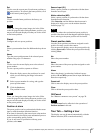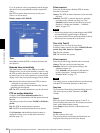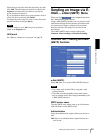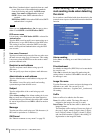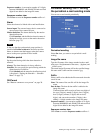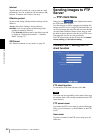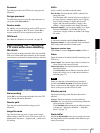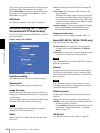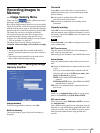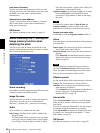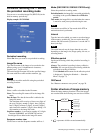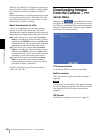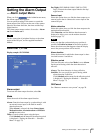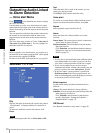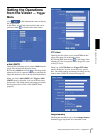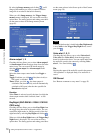
Administrating the Camera
Recording Images in Memory — Image memory Menu
65
Recording Images in
Memory
— Image memory Menu
When you click in the Administrator menu,
the Image memory menu appears.
By using the image memory function, you can record the
image and audio file, which has been shot being linked
with the external sensor input or with the built-in motion
detection function, in the built-in memory (about 8 MB)
The image file can also be recorded periodically.
The recorded image and audio files can be found or
downloaded to the computer using the FTP server
function. (See “Downloading Images from the Camera
— FTP server Menu” on page 68.)
The Image memory menu consists of three tabs:
Common, Alarm recording and Periodical recording.
Notes
• The image and audio files recorded in the built-in
memory are deleted when the power of the camera is
turned.
• The frame rate and operability on the main viewer
may be reduced during image storage.
Common Tab — Setting the image
memory function
Image memory
To use the image memory function, select On.
Built-in memory
The current memory space of the built-in memory is
displayed.
Overwrite
Select On to overwrite the file or not when there is
insufficient memory space to record the image in the
built-in memory.
On: Overwrite is enabled and old files will be
overwritten in the order of date.
Off: Overwrite is prohibited. No recording will be
performed.
Capacity warning
Select On to send a warning mail to the Administrator
when the memory space of the built-in memory is low or
the memory is full. Select Off if you do not want to send
a warning mail.
Note
When Overwrite is set to On, a warning mail is not sent
to the Administrator.
SMTP server name
Type the name of the SMTP server for sending an e-
mail, using up to 64 characters.
Otherwise type the IP address of the SMTP mail server.
Authentication
Select the authentication required when you send an e-
mail.
On: Select if authentication is required when an e-mail
is sent.
Select one of the authentication methods from the
following and specify the POP server name, User
name and Password as required.
SMTP: Select when SMTP authentication is
required.
POP before SMTP: Select when POP before SMTP
authentication is required.
Off: Select if no authentication is required when an e-
mail is sent.
Note
When you set Authentication to On, be sure to select
either or both SMTP or/and POP before SMTP.
POP server name
This is necessary when POP before SMTP is selected
for Authentication.
Type a POP (receiving mail) server name using up to 64
characters, or type the IP address of the POP server. This
setting is necessary when the SMTP server that sends e-
mails performs authentication using the POP user
account.



